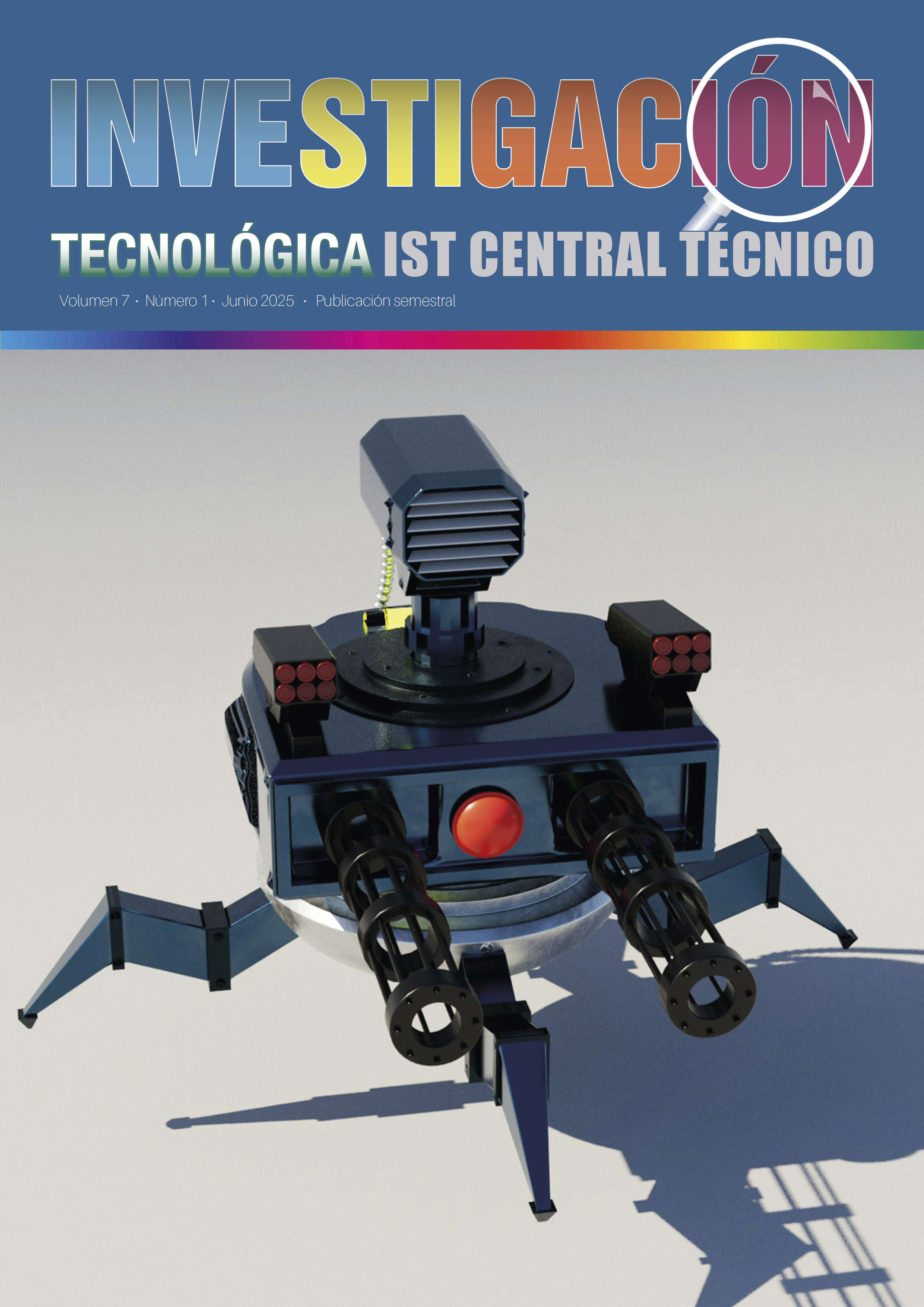Drones: Opportunities and challenges in civilian uses
Keywords:
unmanned vehicle; innovation; technology; driving force.Abstract
Currently, unmanned vehicles have found applications in a wide variety of sectors, ranging from education, medicine, agriculture, and even warfare. These devices have become fundamental drivers of innovative solutions. Their versatility allows them to be used to improve efficiency in various industries, optimizing processes and facilitating tasks that were previously complex or dangerous for humans. The main objective is to analyze the use of drones in Ecuador in non-military applications, evaluating their impact on society. The methodology used is mixed: a bibliographic review of the different applications and types of drones, including ground and aerial, is conducted. Data obtained from surveys conducted among students at an institution and information provided by experts through semi-structured interviews are analyzed. Data analysis is carried out with the help of Atlas.TI software, identifying the main relationships through networks and codes. It is concluded that, as technology advances, the potential of drones continues to expand, offering new opportunities for development and improving the quality of life in multiple areas.
References
-DGAC-DGAC-2020-0110-R-Reglamento-de-RPAs.pdf. (s. f.). Recuperado 23 de octubre de 2023, de https://www.aviacioncivil.gob.ec/wp-content/uploads/downloads/2020/11/5-DGAC-DGAC-2020-0110-R-Reglamento-de-RPAs.pdf
AESA. (2020). Drones | AESA-Agencia Estatal de Seguridad Aérea—Ministerio de Fomento. https://www.seguridadaerea.gob.es/es/ambitos/drones
Bustamante Chipol, D., & Xolo Campechano, J. 5-DGAC-DGAC-2020-0110-R-Reglamento-de-RPAs.pdf. (s. f.). Recuperado 23 de octubre de 2023, de https://www.aviacioncivil.gob.ec/wp-content/uploads/downloads/2020/11/5-DGAC-DGAC-2020-0110-R-Reglamento-de-RPAs.pdf
AESA. (2020). Drones | AESA-Agencia Estatal de Seguridad Aérea—Ministerio de Fomento. https://www.seguridadaerea.gob.es/es/ambitos/drones
Bustamante Chipol, D., & Xolo Campechano, J. (2021). DISEÑO DE MECANISMO TERRESTRE PARA DRONES DE RESCATE EN ZONA DE DIFÍCIL ACCESO. https://rinacional.tecnm.mx/jspui/handle/TecNM/1223
Cárdenas, D. (2021). Diseño de un Framework para la seguridad y privacidad en la implementación de servicio de paquetería mediante drones para el comercio electrónico en el Ecuador. 43.
Ceña Arévalo, D. (2017). Reparto de mercancías a través de drones: Estudio y viabilidad [Master thesis, Universitat Politècnica de Catalunya]. https://upcommons.upc.edu/handle/2117/107148
Cruz, J. (2017). Elementos de la noticiabilidad a partir del uso periodístico de drones en la cobertura del terremoto en Ecuador del 2016. Revista PUCE, 104, 83-107.
Dávalos, N. (2020). Rappi inicia un plan piloto de entregas con drones en Quito. Primicias. https://www.primicias.ec/noticias/tecnologia/rappy-entregas-drone-quito-puembo/
Delgado Penin, J. A. (2021). Drones y redes terrestres celulares para el control/previsión de catástrofes naturales: Aspectos técnicos. CONAMA 2020, Congreso Nacional del Medio Ambiente: 31 Mayo-03 Junio 2021, Centro de Convenciones Norte/IFEMA. https://upcommons.upc.edu/handle/2117/388662
DGAC. (2021). Emisión de permisos de sobrevuelo | Ecuador—Guía Oficial de Trámites y Servicios. https://www.gob.ec/dgac/tramites/emision-permisos-sobrevuelo
DGAC. (2025). Inducción al uso de drones en el Ecuador – Dirección General de Aviación Civil. Dirección General de Aviación Civil. https://www.aviacioncivil.gob.ec/induccion-al-uso-de-drones-en-el-ecuador/
Digital Box. (2019). Diferentes usos de los drones. DIGITAL BOX. https://digitalbox.com.ec/blogs/25_14-usos-de-drones-que-seguro-no-conoc%C3%ADas.html
DJI. (2022). DJI ECUADOR | TIENDA OFICIAL EN ECUADOR. https://djiecuador.ec/
Drones, E. (2019, agosto 23). DJI Ecuador—Drones en Ecuador [Comercial]. https://dronesec.club/dji-ecuador/
Finance. (2023). Los Drones Comerciales están Revolucionando las Operaciones Comerciales | Toptal®. Toptal Finance Blog. https://www.toptal.com/finance/market-research-analysts/los-drones-comerciales-estan-revolucionando-las-operaciones-comerciales
Gutiérrez, A. R. H., Duarte, M. A. T., France, R. G., & León, R. R. arbitrada de divulgación científica de la U. T. de. (2017, enero 23). El uso de drones en ciencias de la tierra. (Ensenada) [Text]. Reaxión. Revista arbitrada de divulgación científica de la Universidad Tecnológica de León. http://reaxion.utleon.edu.mx/Art_El_uso_de_drones_en_ciencias_de_la_tierra.html
Huera Paredes, J. V. (2017). Sistema Aéreo de drones para mejorar el levantamiento topográfico de los predios de la ciudad de Tulcán [bachelorThesis]. https://dspace.uniandes.edu.ec/handle/123456789/6474
Montoya, P. B., & Briones, R. V. (2019). EMPLEO DE LOS UAV, EN OPERACIONES DE SEGURIDAD Y VIGILANCIA EN LAS ÁREAS ESTRATÉGICAS EN EL ECUADOR. Revista de Ciencias de Seguridad y Defensa, 4(4), Article 4. https://doi.org/10.24133/rcsd.V4N4.2019.05
Sarango, S. (2025). Conozca cómo registrar un dron en Ecuador, el trámite está disponible desde este 5 de mayo [Noticias]. PRIMICIAS. https://www.primicias.ec/sociedad/registro-drones-ecuador-tramite-aviacion-civil-dgac-95529/
Toraya, C. V. (2025). LA FASCINANTE HISTORIA DE LOS DRONES. +Ciencia, 37, Article 37.
UMILES. (2022, octubre 6). Tipos de Drones ᐉ Clasificación por uso y características. https://umilesgroup.com/tipos-de-drones/

Downloads
Published
How to Cite
Issue
Section
License
Copyright (c) 2025 Lety Maveliza Satama Rivilla

This work is licensed under a Creative Commons Attribution-NonCommercial 4.0 International License.
COPYRIGHT
The ISTCT Technological Research journal is an Open Access publication, whose contents are disseminated under a Creative Commons Attribution-Non-Commercial license (CC-BY NC 4.0 International). All articles published in the ISTCT Technological Research journal are published in Open Access and are available online for free immediately after publication.
This journal provides metadata for third-party indexing services through the open files initiative.
The ISTCT Technological Research journal recognizes and respects the moral rights of the authors, as well as the ownership of the patrimonial right, which will be transferred non-exclusively to the journal to allow its legal dissemination in Open Access.
The ISTCT Technological Research journal does not reserve the rights to publish articles. Authors may distribute their own material in any other medium or medium, as long as it is for non-commercial purposes, informing the editors that the work will be published again and giving the corresponding credit to the ISTCT Technological Research journal.
Authors can make other independent and additional contractual agreements for the distribution of the article published in this journal (e.g., include it in an institutional repository or publish it in a book) as long as they clearly indicate that the work was published for the first time in "ISTCT Technological Research Magazine". In the case of reproduction, a note similar to the following must be included:
"This text was originally published in REVISTA DE INVESTIGACIÓN TECNOLÓGICA ISTCT N ° -, section -----, number of pages, year of publication."
Authors are recommended to publish their work on the Internet (for example on institutional or personal pages) in the final version published by REVISTA DE INVESTIGACIÓN TECNOLÓGICA ISTCT, as it may lead to a greater and faster dissemination of the published work (see The Effect of Open Access).
The publications in this magazine, due to their free nature, do not entitle the authors to any financial remuneration.


